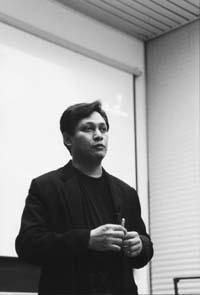Personal tools
News from ICTP 96 - Profile

Saw-Wai Hla recently garnered worldwide publicity for uncovering a technique that enables scientists to study chemical reactions molecule by molecule.
Ultimate Reactions

Former ICTP Diploma student Saw-Wai
Hla, currently a researcher at the Free University in Berlin,
Germany, is an accomplished young scientist whose pathbreaking
work with scanning tunnelling microscopes has been discussed in
virtually every major scientific publication. He is also an accomplished
musician who once earned a living playing bass guitar in a 'boy
band' that produced three albums and made a dozen appearances
on national television in his native country of Myanmar (formerly
Burma) in southeast Asia.
Hla fervently believes that the talents and skills accounting
for his success as a musician are the same ones that he has put
to good use in his scientific endeavours.
"In science as in music," Hla explains, "it's not
enough to master the techniques. You must know how to handle the
instruments. You must also have an emotional attachment to your
work."
"In music that means not just having the ability to play
the correct notes and chords but the feeling to play those
notes and chords in ways that touch and move your audience. In
science that means not just having the ability to master your
laboratory instruments but having an innate feeling of how to
take your research in uncharted directions."
Hla describes how this feeling helped him take the well-known
analytical power of scanning tunnelling microscopes to new heights
by using the tip of the microscope to 'tease' single molecules
through a complicated chemical process known as the Ullman reaction.
The Ullman reaction, which has been part of the tool kit of chemical
laboratories for more than a century, creates multi-ring polymers
by blending countless reacting molecules in large copper-laced
vessels that provide the catalyst for the reaction. Hla and his
colleagues at the Free University in Berlin miniaturised the process
by using electron flows from the tip of the microscope to break
and then rejoin molecules one at a time. A process, previously
characterised by a blur of chemical activity, was reduced to a
step-by-step procedure that allows scientists to visualise the
reaction as it's unfolding.
This breakthrough, which could effectively allow scientists to
probe the most intimate details of chemical reactions molecule
by molecule, also opens up the possibility of building human-made
molecules in the future. "We are not there yet," says
Hla, "but the discovery certainly makes a monomolecular construction
process a possibility." If such a bottom-up molecular construction
technique becomes a reality, it could have an enormous impact
on atomic-scale chemistry and nanoscience and nanotechnology.
Chemical and Engineering News, the flagship publication
of the American Chemical Society, billed Hla's "atom by atom
reaction" as the 'top story' of the week in its 2 November
2000 edition, and this past fall Nature, Science,
Scientific American, Science News, Physics Today
and Physics News all gave extensive coverage to his work.
The press attention generated numerous requests for lectures by
Hla, including presentations at international conferences in Canada,
China, France and Sweden, and invited seminars at IBM's T.J. Watson
Research Center and Clemson University in the United States, and
the University of Freiburg in Germany. It also brought Hla back
to Trieste to speak at the Workshop on Nanoscale Spectroscopy
hosted by ICTP last December.
"I was delighted to return to Trieste," says Hla. That's
where he had spent much of his time during the 1990s--first, from
1992-1993, as a student concentrating on condensed matter physics
in ICTP's Diploma Course (where he completed his thesis under
the direction of Maria Peressi, professor at the University of
Trieste's Department of Theoretical Physics); then from 1994-1997
as a doctoral student at the J. Stefan Institute (IJS) in Ljubljana,
Slovenia, in a programme sponsored jointly by ICTP and IJS (where
he earned a doctorate under Velibor Marinkovic and Albert Prodan,
focussing his research on experimental surface science and thin
film physics); and finally, from 1997-1998, as a fellow in ICTP's
Training and Research in Italian Laboratories (TRIL) programme,
working at the TASC laboratory at the Elettra synchrotron
light facility in Area Science Park, Trieste, on experiments related
to surface science.
"I owe my success," Hla notes, "largely to the
education and training I received in Trieste. My experience there
allowed me the opportunity to hone my skills both in theory and
experimentation. I hope to put this background to use again in
moving my research from the realm of laboratory observations (the
ability to use the scanning tunnelling microscope to see the most
intimate details of chemical reactions) to the world of molecular
manipulation and creation, which could spur the creation of novel
chemical compounds that cannot be made through conventional means."
"I consider myself an alumnus of ICTP and, more generally,
of the Trieste scientific community. There's no doubt that ICTP
and the intricate network of scientific institutions in Trieste
and the surrounding area are largely responsible for whatever
success I have achieved to date and whatever success I might achieve
in the future."